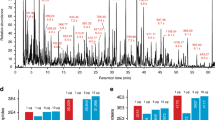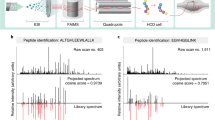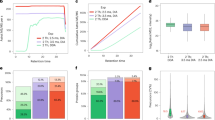Abstract
The majority of proteome-wide studies rely on the high separation power of two-dimensional liquid chromatography–tandem mass spectrometry (2D LC-MS/MS), often combined with protein prefractionation. Alternative approaches would be advantageous in order to reduce the analysis time and the amount of sample required. On the basis of the recent advances in chromatographic and mass spectrometric instrumentation, thousands of proteins can be identified in a single-run LC-MS/MS experiment using ultralong gradients. Consequently, the analysis of simple proteomes or clinical samples in adequate depth becomes possible by performing single-run LC-MS/MS experiments. Here we present a generally applicable protocol for protein analysis from unseparated whole-cell extracts and discuss its potential and limitations. Demonstrating the practical applicability of the method, we identified 2,761 proteins from a HeLa cell lysate, requiring around 10 h of nanoLC-MS/MS measurement time.
This is a preview of subscription content, access via your institution
Access options
Subscribe to this journal
Receive 12 print issues and online access
$259.00 per year
only $21.58 per issue
Buy this article
- Purchase on Springer Link
- Instant access to full article PDF
Prices may be subject to local taxes which are calculated during checkout




Similar content being viewed by others
References
Gstaiger, M. & Aebersold, R. Applying mass spectrometry-based proteomics to genetics, genomics and network biology. Nat. Rev. Genet. 10, 617–627 (2009).
Han, X.M., Aslanian, A. & Yates, J.R. Mass spectrometry for proteomics. Curr. Opin. Chem. Biol. 12, 483–490 (2008).
Gavin, A.C. et al. Functional organization of the yeast proteome by systematic analysis of protein complexes. Nature 415, 141–147 (2002).
Zak, D.E. & Aderem, A. Systems biology of innate immunity. Immunol. Rev. 227, 264–282 (2009).
Hood, L. & Perlmutter, R.M. The impact of systems approaches on biological problems in drug discovery. Nat. Biotechnol. 22, 1215–1217 (2004).
Köcher, T. & Superti-Furga, G. Mass spectrometry-based functional proteomics: from molecular machines to protein networks. Nat. Methods 4, 807–815 (2007).
Rix, U. & Superti-Furga, G. Target profiling of small molecules by chemical proteomics. Nat. Chem. Biol. 5, 616–624 (2009).
Washburn, M.P., Wolters, D. & Yates, J.R. Large-scale analysis of the yeast proteome by multidimensional protein identification technology. Nat. Biotechnol. 19, 242–247 (2001).
Motoyama, A. & Yates, J.R. Multidimensional LC separations in shotgun proteomics. Anal. Chem. 80, 7187–7193 (2008).
de Godoy, L.M.F. et al. Comprehensive mass-spectrometry-based proteome quantification of haploid versus diploid yeast. Nature 455, U1251–U1260 (2008).
Köcher, T., Swart, R. & Mechtler, K. Ultra-high-pressure RPLC hyphenated to an LTQ-Orbitrap Velos reveals a linear relation between peak capacity and number of identified peptides. Anal. Chem. 83, 2699–2704 (2011).
Thakur, S.S. et al. Deep and highly sensitive proteome coverage by LC-MS/MS without prefractionation. Mol. Cell. Proteomics 10, M110.003699 (2011).
Spahr, C.S. et al. Simplification of complex peptide mixtures for proteomic analysis: Reversible biotinylation of cysteinyl peptides. Electrophoresis 21, 1635–1650 (2000).
Shen, Y.F. et al. Automated 20 kpsi RPLC-MS and MS/MS with chromatographic peak capacities of 1000–1500 and capabilities in proteomics and metabolomics. Anal. Chem. 77, 3090–3100 (2005).
Christoforou, A. & Lilley, K.S. Taming the isobaric tagging elephant in the room in quantitative proteomics. Nat. Methods 8, 911–913 (2011).
Köcher, T., Pichler, P., Swart, R. & Mechtler, K. Quality control in LC-MS/MS. Proteomics 11, 1026–1030 (2011).
Manza, L.L., Stamer, S.L., Ham, A.J.L., Codreanu, S.G. & Liebler, D.C. Sample preparation and digestion for proteomic analyses using spin filters. Proteomics 5, 1742–1745 (2005).
Olsen, J.V., Ong, S.E. & Mann, M. Trypsin cleaves exclusively C-terminal to arginine and lysine residues. Mol. Cell. Proteomics 3, 608–614 (2004).
Wilm, M. Principles of electrospray ionization. Mol. Cell. Proteomics 10, M111.009407 (2011).
Wilm, M. & Mann, M. Analytical properties of the nanoelectrospray ion source. Anal. Chem. 68, 1–8 (1996).
Shen, Y.F. et al. High-efficiency nanoscale liquid chromatography coupled on-line with mass spectrometry using nanoelectrospray ionization for proteomics. Anal. Chem. 74, 4235–4249 (2002).
Rappsilber, J., Mann, M. & Ishihama, Y. Protocol for micro-purification, enrichment, pre-fractionation and storage of peptides for proteomics using StageTips. Nat. Protoc. 2, 1896–1906 (2007).
Mitulovic, G. et al. An improved method for tracking and reducing the void volume in nano HPLC-MS with micro trapping columns. Anal. Bioanal. Chem. 376, 946–951 (2003).
Mitulovic, G. et al. Preventing carryover of peptides and proteins in nano LC-MS separations. Anal. Chem. 81, 5955–5960 (2009).
Olsen, J.V. et al. Higher-energy C-trap dissociation for peptide modification analysis. Nat. Methods 4, 709–712 (2007).
Syka, J.E.P., Coon, J.J., Schroeder, M.J., Shabanowitz, J. & Hunt, D.F. Peptide and protein sequence analysis by electron transfer dissociation mass spectrometry. Proc. Natl. Acad. Sci. USA 101, 9528–9533 (2004).
Steen, H. & Mann, M. The ABC's (and XYZ's) of peptide sequencing. Nat. Rev. Mol. Cell Biol. 5, 699–711 (2004).
Nesvizhskii, A.I., Vitek, O. & Aebersold, R. Analysis and validation of proteomic data generated by tandem mass spectrometry. Nat. Methods 4, 787–797 (2007).
Elias, J.E. & Gygi, S.P. Target-decoy search strategy for increased confidence in large-scale protein identifications by mass spectrometry. Nat. Methods 4, 207–214 (2007).
Bradshaw, R.A., Burlingame, A.L., Carr, S. & Aebersold, R. Reporting protein identification data—The next generation of guidelines. Mol. Cell Proteomics 5, 787–788 (2006).
Gupta, N. & Pevzner, P.A. False discovery rates of protein identifications: A strike against the two-peptide rule. J. Proteome Res. 8, 4173–4181 (2009).
Köcher, T., Pichler, P., Swart, R. & Mechtler, K. Preparation of HeLa peptides for LC-MS. Protocol Exchange published online, doi10.1038/protex.2012.001 (2012).
Olsen, J.V. et al. Parts per million mass accuracy on an orbitrap mass spectrometer via lock mass injection into a C-trap. Mol. Cell Proteomics 4, 2010–2021 (2005).
Deutsch, E.W. et al. A guided tour of the trans-proteomic pipeline. Proteomics 10, 1150–1159 (2010).
Keller, A., Nesvizhskii, A.I., Kolker, E. & Aebersold, R. Empirical statistical model to estimate the accuracy of peptide identifications made by MS/MS and database search. Anal. Chem. 74, 5383–5392 (2002).
Nesvizhskii, A.I., Keller, A., Kolker, E. & Aebersold, R. A statistical model for identifying proteins by tandem mass spectrometry. Anal. Chem. 75, 4646–4658 (2003).
Cox, J. et al. A practical guide to the MaxQuant computational platform for SILAC-based quantitative proteomics. Nat. Protoc. 4, 698–705 (2009).
Michalski, A., Cox, J. & Mann, M. More than 100,000 detectable peptide species elute in single shotgun proteomics runs but the majority is inaccessible to data-dependent LC-MS/MS. J. Proteome Res. 10, 1785–1793 (2011).
Olsen, J.V. et al. A dual pressure linear ion Trap Orbitrap instrument with very high sequencing speed. Mol. Cell Proteomics 8, 2759–2769 (2009).
Acknowledgements
This work was funded by Boehringer Ingelheim, the Christian Doppler Research Association, the Austrian Proteomics Platform within the Austrian GenomeResearch program (GEN-AU), the Austrian Science Fund via the Special Research Program Chromosome Dynamics (SFB-F3402) and the European Commission via the FP7 projects MeioSys and Prime XS. The technical support of the other members of the Mechtler group, especially of G. Krssakova, is gratefully acknowledged.
Author information
Authors and Affiliations
Contributions
T.K. and K.M. designed the study. T.K. and P.P. performed experiments and analyzed the data. R.S. provided conceptual input and assisted in the experimental design. T.K. and K.M. supervised the project. All authors discussed the experimental results. T.K. wrote the manuscript.
Corresponding authors
Ethics declarations
Competing interests
The authors declare no competing financial interests.
Rights and permissions
About this article
Cite this article
Köcher, T., Pichler, P., Swart, R. et al. Analysis of protein mixtures from whole-cell extracts by single-run nanoLC-MS/MS using ultralong gradients. Nat Protoc 7, 882–890 (2012). https://doi.org/10.1038/nprot.2012.036
Published:
Issue Date:
DOI: https://doi.org/10.1038/nprot.2012.036
This article is cited by
-
Comparative proteome analysis of different Saccharomyces cerevisiae strains during growth on sucrose and glucose
Scientific Reports (2023)
-
A general approach to explore prokaryotic protein glycosylation reveals the unique surface layer modulation of an anammox bacterium
The ISME Journal (2022)
-
Novel interconnections of HOG signaling revealed by combined use of two proteomic software packages
Cell Communication and Signaling (2019)
-
High-Resolution Nano-Liquid Chromatography with Tandem Mass Spectrometric Detection for the Bottom-Up Analysis of Complex Proteomic Samples
Chromatographia (2019)
-
Integrated analysis of shotgun proteomic data with PatternLab for proteomics 4.0
Nature Protocols (2016)
Comments
By submitting a comment you agree to abide by our Terms and Community Guidelines. If you find something abusive or that does not comply with our terms or guidelines please flag it as inappropriate.



